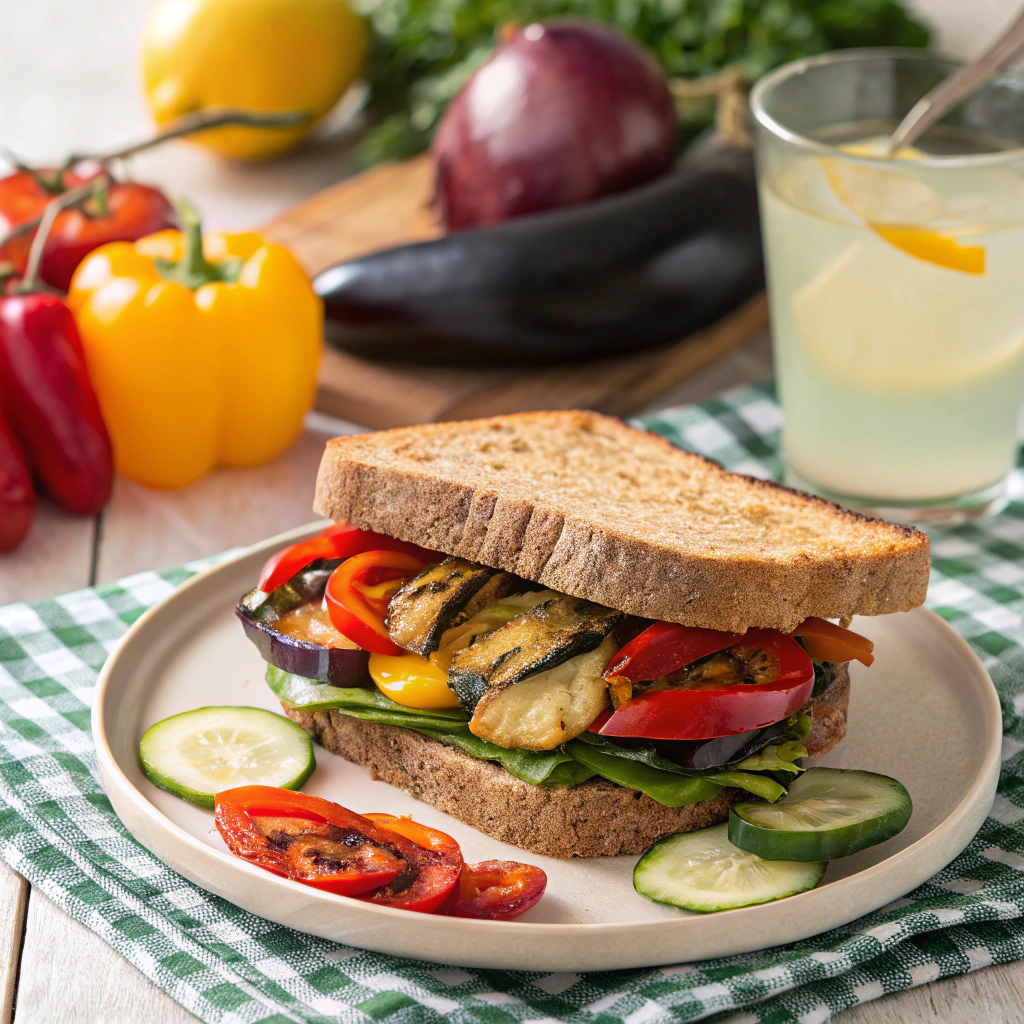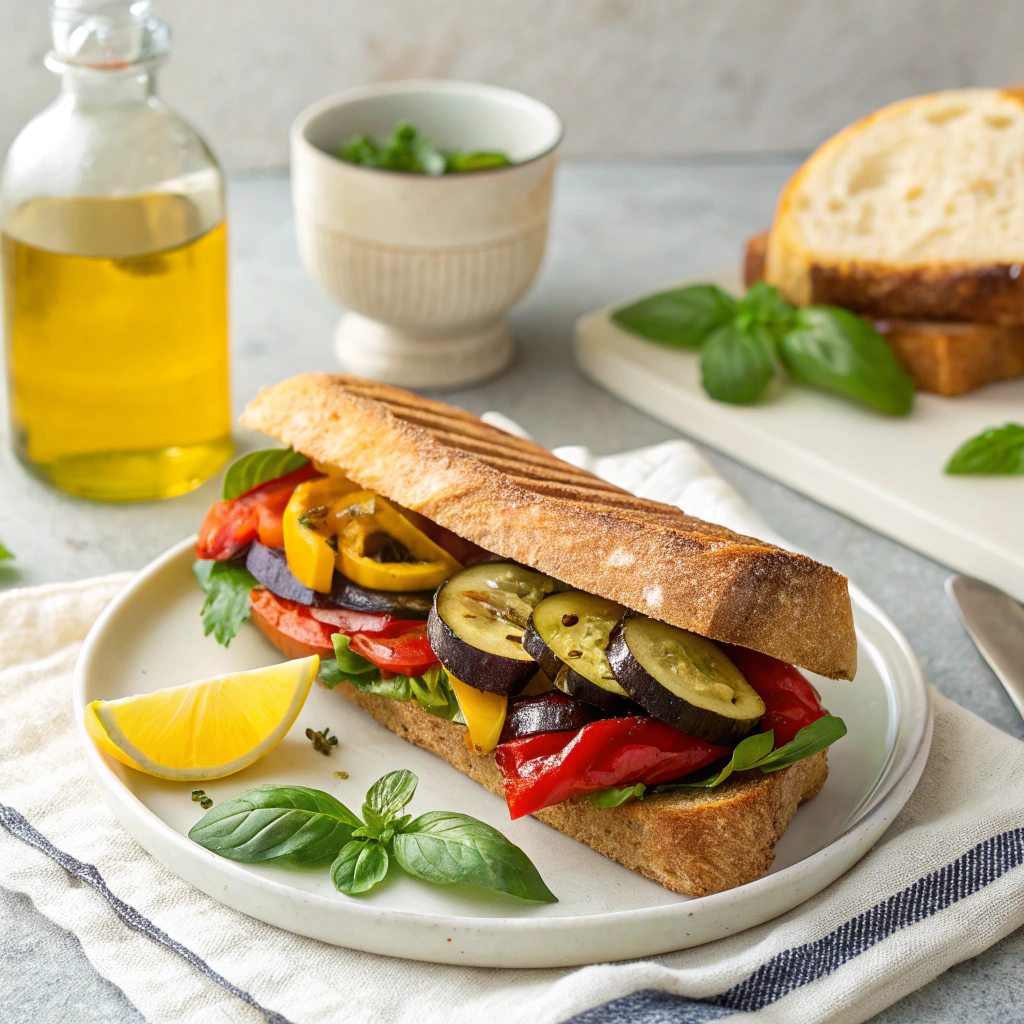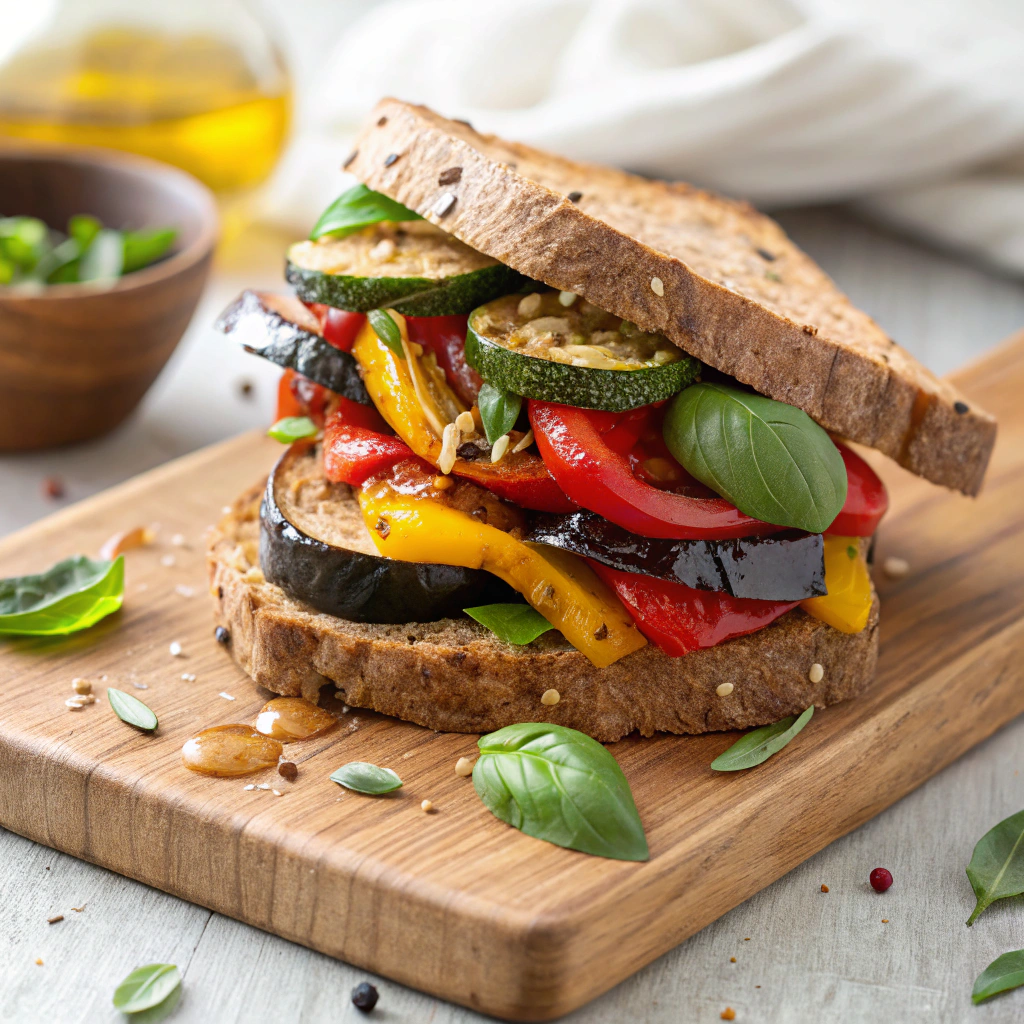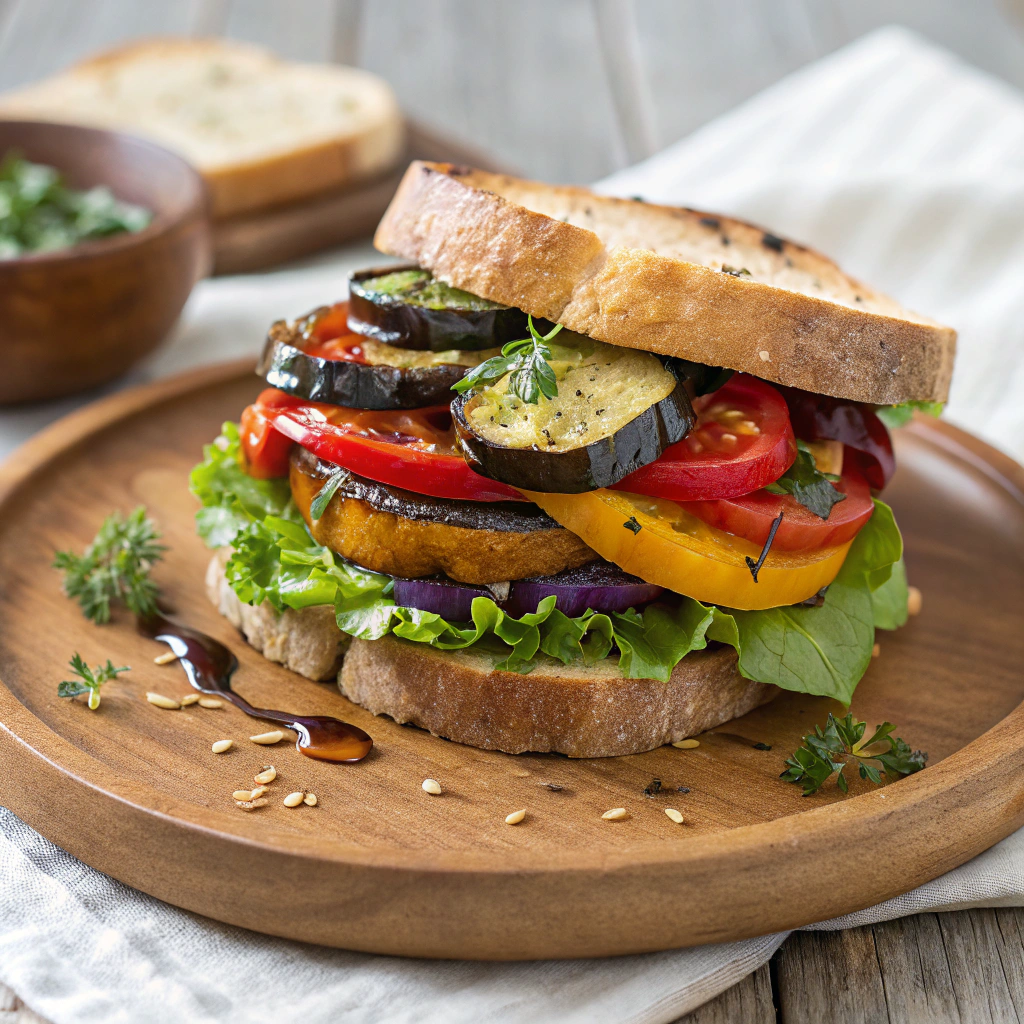
Introduction
Imagine this: It’s a cozy weekend afternoon, and you’re craving something warm, satisfying, and packed with flavor. You don’t want anything too heavy, but you still desire a meal that feels indulgent. Enter the roasted veggie sandwich—a culinary masterpiece that combines vibrant colors, rich textures, and irresistible aromas. This isn’t just any ordinary sandwich; it’s a celebration of fresh ingredients, simple techniques, and creativity in the kitchen.
If you’ve ever thought about making your own roasted veggie sandwich but weren’t sure where to start, you’re in the right place. Whether you’re a vegetarian, vegan, or simply looking for a plant-based option, this guide will walk you through every step of creating a delicious, wholesome meal. Not only is it easy to prepare, but it also offers numerous health benefits, from boosting your nutrient intake to supporting sustainable eating habits. So grab your apron, and let’s dive into how you can make a mouth-watering roasted veggie sandwich right at home!
Choosing the Right Vegetables for Your Sandwich
The foundation of a great roasted veggie sandwich lies in selecting the perfect vegetables. Here’s what you need to know:
Best Veggies for Roasting
- Bell peppers: Sweet and slightly smoky when roasted.
- Zucchini: Adds moisture and a mild flavor.
- Eggplant: Provides a creamy texture when cooked properly.
- Mushrooms: Earthy and hearty, they mimic meat-like qualities.
- Carrots: Naturally sweet and crunchy when roasted.
- Broccoli: Nutritious and adds a pop of green.
Why These Work Well:
Roasting enhances the natural sugars in vegetables, giving them a caramelized finish that pairs beautifully with bread and spreads.
Seasonal Vegetable Options
- Spring: Asparagus, radishes, and peas.
- Summer: Tomatoes, corn, and zucchini.
- Fall: Sweet potatoes, squash, and Brussels sprouts.
- Winter: Beets, carrots, and turnips.
Key Point:
Using seasonal produce ensures peak freshness and flavor while supporting local farmers.
Prepping Vegetables for Maximum Flavor
- Slice evenly for uniform cooking.
- Toss in olive oil, salt, pepper, and spices before roasting.
- Marinate overnight for deeper flavors (optional).
| Ingredient | Quantity | Prep Tip |
|---|---|---|
| Bell Peppers | 2 medium | Cut into strips. |
| Zucchini | 1 large | Slice thinly. |
| Eggplant | 1 small | Cube or slice. |
| Mushrooms | 8 oz | Clean and halve. |
Selecting the Perfect Bread Base
Your choice of bread sets the stage for your sandwich. Here’s how to pick wisely:
Types of Bread for a Roasted Veggie Sandwich
- Sourdough: Offers a tangy flavor and sturdy texture.
- Whole Wheat: A healthier option with added fiber.
- Ciabatta: Crusty exterior with a soft interior.
- Baguette: Ideal for smaller sandwiches or appetizers.
Toasting vs. Non-Toasting
- Toasting : Adds crunch and prevents sogginess.
- Non-Toasting : Keeps the sandwich softer and more rustic.
Gluten-Free Alternatives
For those avoiding gluten, try:
- Gluten-free sourdough.
- Rice-based bread.
- Wraps made from chickpea flour.
Pro Tip:
Toast gluten-free bread lightly to enhance its structure and prevent crumbling.

Adding Flavorful Spreads and Toppings
A good spread or topping can elevate your sandwich from ordinary to extraordinary. Let’s explore some options:
Popular Spreads
- Hummus: Creamy and protein-rich.
- Pesto: Bursting with basil and pine nut goodness.
- Tahini: Nutty and slightly bitter, balancing sweetness.
- Balsamic Glaze: Adds a tangy kick.
Cheesy Additions
- Goat Cheese: Tangy and crumbly.
- Feta: Salty and refreshing.
- Mozzarella: Melty and mild.
Fresh Herbs and Spices
- Basil: Sweet and fragrant.
- Oregano: Earthy and aromatic.
- Garlic Powder: Enhances savory notes.
- Smoked Paprika: Brings depth and warmth.
Optional Extras
- Arugula Salad: Adds peppery freshness.
- Avocado Slices: Creamy and nutritious.
Mastering the Art of Roasting Vegetables
Roasting is an art form that transforms humble vegetables into gourmet delights. Follow these steps to achieve perfection:
Cooking Techniques
- Oven Roasting : Best for larger batches; distributes heat evenly.
- Skillet Roasting : Faster and ideal for smaller portions.
Ideal Temperature and Timing
- Set your oven to 400°F (200°C).
- Roast vegetables for 20-30 minutes, flipping halfway through.
Marinating Vegetables Before Roasting
Try this marinade recipe:
- 2 tbsp olive oil
- 1 tsp balsamic vinegar
- 1 tsp smoked paprika
- Salt and pepper to taste
Benefits of Marinating:
Marinating locks in moisture and intensifies flavors during cooking.
Serving and Storing Your Roasted Veggie Sandwich
Once your sandwich is ready, there are endless ways to enjoy it. Here’s how to take it further:
Creative Ways to Serve
- Pair with a warm tomato soup for comfort food vibes.
- Add a side salad for extra nutrients.
- Serve alongside roasted potatoes for a heartier meal.
Meal Prep Tips
- Roast vegetables in bulk and store them in an airtight container for up to 5 days.
- Slice bread and freeze portions for quick assembly later.
Storing Leftovers
- Keep sandwiches wrapped tightly in foil or plastic wrap.
- Refrigerate for up to 2 days or freeze for longer storage.
Portable Options
- Use wax paper or parchment to wrap sandwiches securely.
- Pack with napkins and utensils for convenience.

FAQ Section
Q: What makes a roasted veggie sandwich so special?
A: A roasted veggie sandwich stands out because of its ability to combine fresh, flavorful vegetables with hearty bread and complementary toppings. The roasting process brings out the natural sweetness and texture of the veggies, making each bite memorable.
Q: Can I use frozen vegetables for my roasted veggie sandwich?
A: While fresh vegetables are preferred, frozen ones work well too. Just thaw them first and pat dry to avoid excess moisture.
Q: Is a roasted veggie sandwich suitable for vegans?
A: Absolutely! By choosing plant-based spreads like hummus or pesto and skipping dairy-based cheeses, you can create a fully vegan roasted veggie sandwich.
Enhancing Your Sandwich with Unique Ingredients
While the basics of a roasted veggie sandwich are simple, there’s always room for creativity. Here are some unique ingredients that can take your sandwich to the next level:
Incorporating Nuts and Seeds
- Walnuts : Add crunch and healthy fats.
- Pumpkin Seeds : Nutritious and earthy.
- Almonds : Toasted almonds provide a buttery flavor.
How to Use:
Sprinkle crushed nuts or seeds over the top of your sandwich for added texture and nutrition.
Adding Fruit for Sweetness
- Dried Cranberries : A touch of sweetness that pairs well with savory elements.
- Sliced Apples : Thin slices of apple add freshness and juiciness.
- Roasted Grapes : Caramelized grapes bring a burst of sweetness.
Why It Works:
The combination of sweet and savory creates a balanced flavor profile that keeps you coming back for more.
Experimenting with Global Flavors
- Middle Eastern Twist : Add za’atar seasoning, labneh cheese, and pickled turnips.
- Mediterranean Style : Include kalamata olives, sun-dried tomatoes, and feta.
- Asian Fusion : Try soy sauce glaze, sesame seeds, and kimchi.
Pro Tip:
Don’t be afraid to mix and match flavors from different cuisines to create something truly unique.
Perfect Pairings for Your Roasted Veggie Sandwich
A great sandwich deserves an equally delicious accompaniment. Here are some ideas for what to serve alongside your roasted veggie creation:
Soups That Complement Sandwiches
For a classic pairing, consider serving your roasted veggie sandwich with a warm bowl of soup. Tomato basil soup is always a crowd-pleaser, but if you’re feeling adventurous, try experimenting with other recipes like this lentil soup from Minimalist Baker . It’s hearty, plant-based, and perfect for colder days.
- Tomato Basil Soup : Classic and comforting.
- Lentil Soup : Hearty and filling.
- Minestrone Soup : Packed with vegetables and herbs.
Why Soups Work:
They provide warmth and moisture, balancing the dryness of bread-based meals.
Salads for Extra Nutrition
- Kale Caesar Salad : Creamy dressing meets robust greens.
- Quinoa Salad : Protein-rich and versatile.
- Caprese Salad : Fresh mozzarella, tomatoes, and basil.
Benefits of Salads:
They add freshness, color, and extra nutrients to your meal.
Side Dishes for Variety
- Garlic Bread : A classic side that enhances any sandwich.
- Sweet Potato Fries : Crispy and satisfying.
- Roasted Chickpeas : High in protein and fiber.
Creative Idea:
Make mini sliders instead of full sandwiches and pair them with a variety of sides for a party platter.
Meal Prep and Batch Cooking Tips
One of the best things about roasted veggie sandwiches is their adaptability for meal prep. Here’s how to make the most of this convenience:
Preparing Vegetables in Advance
- Roast large batches of vegetables at once.
- Store them in separate containers to preserve freshness.
- Reheat only the portion you need for each meal.
Storage Hacks:
Use silicone bags or glass containers to keep vegetables fresher for longer.
Assembling Sandwiches Quickly
- Keep pre-sliced bread ready in the freezer.
- Have spreads prepared in small jars for easy access.
- Layer ingredients efficiently by starting with sturdier components (like cheese) before adding delicate ones (like lettuce).
Time-Saving Tip:
Assemble sandwiches partially ahead of time, leaving out perishable items like avocado until just before serving.
Troubleshooting Common Issues
Even experienced cooks encounter challenges when making roasted veggie sandwiches. Here’s how to overcome them:
Preventing Soggy Bread
- Toast the bread lightly before assembling.
- Use less juicy vegetables or blot excess moisture with paper towels.
- Apply spreads sparingly to avoid saturation.
Achieving Evenly Roasted Vegetables
- Cut vegetables into uniform sizes for consistent cooking.
- Avoid overcrowding the pan to allow heat circulation.
- Rotate the baking sheet halfway through cooking.
Balancing Flavors
- Taste as you go and adjust seasonings accordingly.
- Start with mild spices and gradually increase intensity.
- Mix strong flavors (like goat cheese) with milder ones (like arugula).

Health Benefits of Roasted Veggie Sandwiches
Beyond being delicious, roasted veggie sandwiches offer numerous health benefits. Here’s why they’re worth incorporating into your diet:
Rich in Nutrients
- Vegetables provide vitamins, minerals, and antioxidants.
- Whole grain bread contributes fiber and energy.
- Healthy fats from nuts, seeds, and oils support heart health.
Supports Weight Management
- Low in calories but high in volume, keeping you full longer.
- Customizable portions allow for mindful eating.
Environmentally Friendly
- Plant-based diets reduce carbon footprint.
- Using seasonal produce supports sustainable farming practices.
Fun Fact:
Did you know that eating more plant-based meals can lower your risk of chronic diseases? It’s one reason why roasted veggie sandwiches are such a smart choice!
FAQ Section Continued
Q: Can I freeze my roasted veggie sandwich for later?
A: While freezing isn’t ideal due to potential sogginess upon thawing, you can freeze individual components like roasted vegetables or bread slices. Assemble the sandwich fresh when ready to eat.
Q: How do I make my roasted veggie sandwich more filling?
A: Add protein sources like chickpeas, lentils, or tofu. Alternatively, incorporate nut butters or creamy cheeses for richness.
Q: Is it okay to use store-bought roasted vegetables?
A: Yes, pre-roasted vegetables save time and effort. Just ensure they’re minimally processed and free from unwanted additives.
Conclusion
Creating a mouth-watering roasted veggie sandwich at home is not only rewarding but also incredibly versatile. From choosing the right vegetables and bread to experimenting with global flavors and unique toppings, the possibilities are endless. By following the tips outlined in this guide, you’ll master the art of crafting a satisfying, nutritious, and visually appealing meal.
Remember, cooking should be fun and personal—so don’t hesitate to tweak recipes to suit your tastes. Whether you’re enjoying a quiet lunch at home or hosting a gathering with friends, your roasted veggie sandwich will surely steal the show.
Now it’s your turn! Share your favorite variations, ask questions, or leave feedback in the comments below. Together, let’s celebrate the joy of homemade food. Happy cooking! 🍴✨
